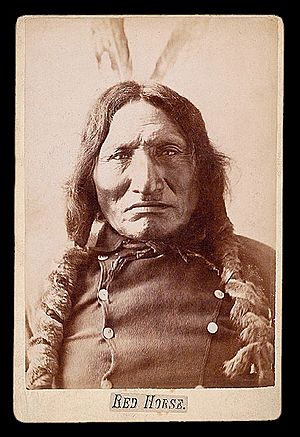Red Horse (Lakota chief) facts for kids
Quick facts for kids
Red Horse
|
|
|---|---|
| Tasunka Luta | |

Red Horse (1822-1907), Miniconjou Sioux chief. Commercial cabinet card published by David F. Barry (1854-1934)
|
|
| Born | 1822 |
| Died | 1907 |
| Known for | Battle of the Little Bighorn |
Red Horse was an important leader of the Miniconjou Sioux people. He was known as a sub-chief, which means he was a leader who helped guide his community.
Red Horse is famous for his role in the 1876 Battle of the Little Bighorn. He also created detailed drawings of this battle. These drawings are very important because they show the event from a Native American point of view. Red Horse was married twice and had three children.
Red Horse's Amazing Drawings
Red Horse created 42 special drawings that tell the story of the Battle of Little Bighorn. These drawings are a type of art called ledger art. They are now kept at the Smithsonian Institution’s National Anthropological Archives. Some of them have even been shown in art exhibitions.
What Are Ledger Drawings?
Ledger art got its name because artists often drew on old ledger books. These were books used for keeping records, like accounting ledgers. Red Horse made his drawings in 1881. He used colored pencils on manila paper, which is a type of sturdy paper. An Army doctor named Charles E. McChesney asked him to create these drawings.
Why Are His Drawings Important?
Red Horse's drawings show the battle in a very realistic way. They depict hand-to-hand fighting and give a clear picture of what happened. Experts say these drawings are "the most trustworthy" visual record of the battle. This is because they focus on the Native American experience. They do not focus on General George Custer's role, which was often the main focus in other accounts.

